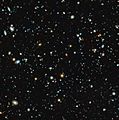Fornax facts for kids
| Constellation | |

List of stars in Fornax
|
|
| Abbreviation | For |
|---|---|
| Genitive | Fornacis |
| Pronunciation | genitive |
| Symbolism | the brazier |
| Right ascension | 3 |
| Declination | −30 |
| Quadrant | SQ1 |
| Area | 398 sq. deg. (41st) |
| Main stars | 2 |
| Bayer/Flamsteed stars |
27 |
| Stars with planets | 7 |
| Stars brighter than 3.00m | 0 |
| Stars within 10.00 pc (32.62 ly) | 2 |
| Brightest star | α For (3.80m) |
| Messier objects | None |
| Meteor showers | None |
| Bordering constellations |
Cetus Sculptor Phoenix Eridanus |
| Visible at latitudes between +50° and −90°. Best visible at 21:00 (9 p.m.) during the month of December. |
|
Fornax is a small constellation you can see in the southern sky. Its name comes from a Latin word meaning "furnace." It was first named in the 1700s and is now one of the 88 official constellations we recognize today.
Contents
Discovering Fornax
Fornax was first identified by a French astronomer named Nicolas Louis de Lacaille in 1756. He originally called it "Fornax Chemica." This means "chemical furnace." It was named after a small heater used by scientists to warm up their experiments.
What Makes Fornax Special?
Fornax is a very interesting area for scientists who study the universe. They look here to find the furthest and oldest things in space!
The Hubble Ultra Deep Field
One of the most famous parts of Fornax is the Hubble Ultra Deep Field. This is a tiny patch of sky that the Hubble Space Telescope stared at for a very long time. It captured images of thousands of very distant galaxies. These galaxies are so far away that their light has traveled for billions of years to reach us. Looking at them is like looking back in time!
The Fornax Cluster
Fornax is also home to the Fornax Cluster. This is a group of many galaxies that are close to each other. Scientists have found many "dwarf" galaxies in this cluster. These dwarf galaxies are much smaller than regular galaxies. Some are only about 120 light-years across.
NGC 1316: A Bright Galaxy
One of the brightest galaxies in the Fornax Cluster is called NGC 1316. It's an elliptical galaxy, which means it has a smooth, oval shape. This galaxy is also known for being a very strong source of radio waves in the sky.
Images for kids
-
Fornax Chemica can be seen below Cetus in this card from Urania's Mirror (1825).
-
The Hubble Ultra Deep Field seen with MUSE.
See also
 In Spanish: Fornax para niños
In Spanish: Fornax para niños






